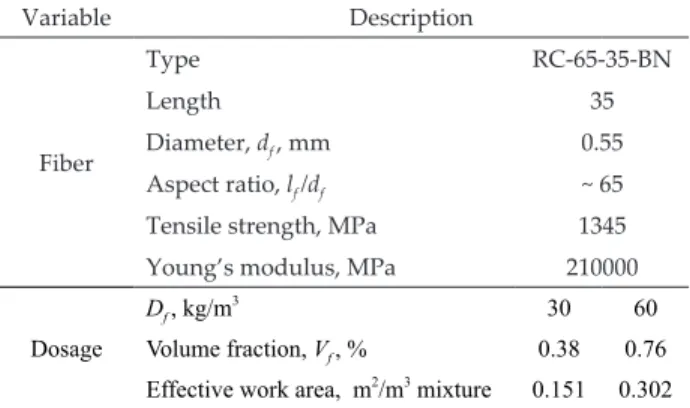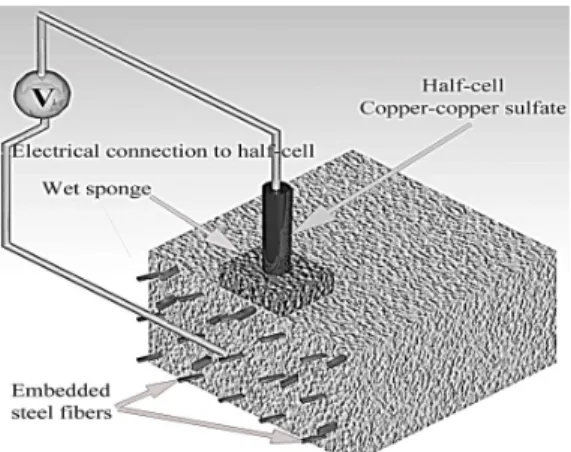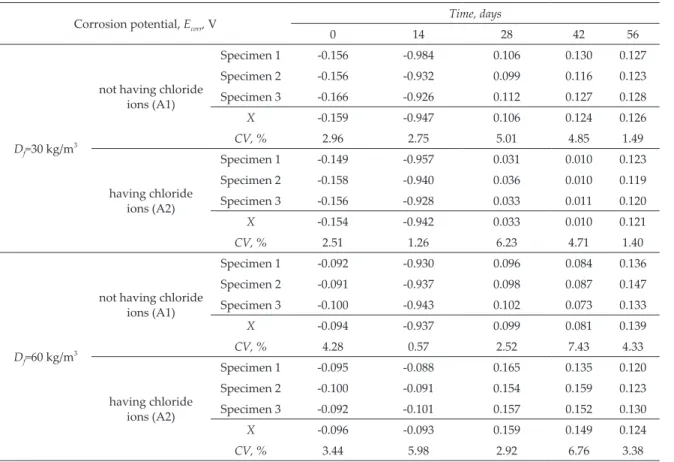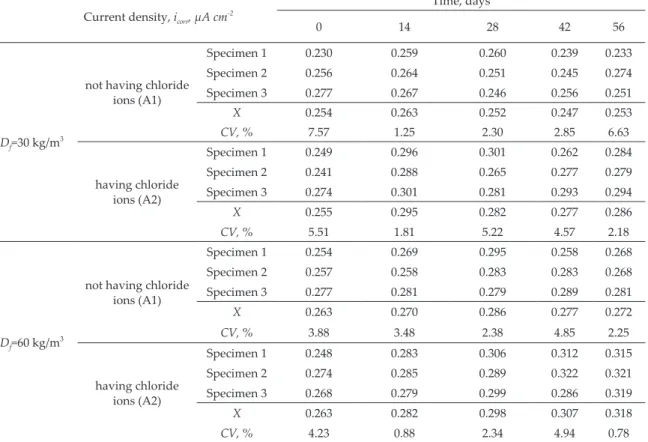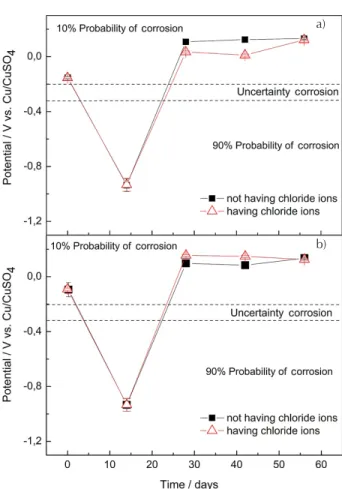Abstract
The use of concrete reinforced with steel fibers is relatively limited in Latin America due to its high cost. However, its mechanical performance is very useful in the construction of reinforced concrete structures. This article describes and discusses the results of an experimental research, which reflects the chloride ion effects at a short term, on the durability properties of concrete reinforced with RC-65-35-BN steel fibers using dosages of 30 and 60 kg/m3. In order to predict the effect of chloride ion on the steel fiber reinforced concrete, trends of corrosion were estimated during 56 days by half-cell potential and linear polarization resistance tests. Additionally, the surfaces of the steel fibers were analyzed by X-ray diffraction with the purpose to determinate the corrosion products that were generated. The obtained results demonstrates an adequate performance of the fibers embedded in the concrete for this phase of co-rrosion initiation, due to its low probability of coco-rrosion.
Keywords: steel fibers, concrete, corrosion, half-cell potential, corrosion products.
Resumen
El uso del concreto reforzado con fibras de acero es relativamente limitado en Latinoamérica debido a su alto costo. Sin embargo, su desempeño mecánico es muy útil en la construcción de estructuras de concreto reforzado. Este artí-culo describe y discute los resultados de un estudio experimental que refleja el efecto del ion cloruro a corto plazo, sobre las propiedades de durabilidad del concreto reforzado con fibras de acero RC-65/35-BN usando dosificaciones de fibra de 30 kg/m3 y 60 kg/m3. Con el fin de predecir el efecto del ion cloruro sobre el concreto reforzado con fibras de acero, las tendencias de la corrosión se estimaron durante 56 días mediante ensayos de potencial de media celda y resistencia a la polarización lineal. Adicionalmente, las superficies de las fibras de acero se analizaron por difrac-ción de rayos X con el propósito de determinar los productos de corrosión generados. Para esta fase de iniciadifrac-ción de la corrosión, los resultados obtenidos demuestran un adecuado desempeño de las fibras embebidas en el concreto debido a su baja probabilidad de corrosión.
Descriptores: fibras de acero, concreto, corrosión, potencial de media celda, productos de corrosión.
Efecto del ion cloruro sobre las propiedades de durabilidad del concreto reforzado
con fibras de acero RC-65/35-BN
Aperador-Chaparro William
Universidad Militar Nueva Granada, Bogotá, Colombia Departamento de Ingeniería Mecatrónica
E-mail: william.aperador@unimilitar.edu.co
Carrillo Julian
Universidad Militar Nueva Granada, Bogotá, Colombia Departamento de Ingeniería Civil
E-mail: wjcarrillo@gmail.com
Cárdenas-Pulido Jhon
Universidad Militar Nueva Granada, Bogotá, Colombia Departamento de Ingeniería Civil
E-mail: u1100907@unimilitar.edu.co
DOI: http://dx.doi.org/10.22201/fi.25940732e.2017.18n2.012
IntroductIon
Due to the simplicity of construction and versatility of the steel fiber reinforced concrete (SFRC), its use has in-creased significantly in recent years. SFRC is currently used in many fields of the civil engineering such as air-port pavements, industrial floors, hydraulic structures, beams and walls for buildings, supporting under-ground tunnels, coatings with shotcrete or sprayed concrete (Abbas et al., 2014; Mahmud et al., 2013;
Caba-llero et al., 2013; Johnston, 1982; Ramzi y Omer, 1999).
The corrosion of the rebar by the action of the chlo-ride ion is one of the main causes of the premature de-terioration in concrete structures by oxidation of the rebar (Granju y Balounch, 2005). This deterioration is due to the urban and industrial development in coastal zones across the whole world, where the sea salt is one of the principal adverse factors. The chloride ions are found in a small quantity in the environment, and the-refore, they may be present in products used in the con-crete mix such a cement, coarse and fine aggregates and mixing water. The quantities of these products are low in comparison with the mass or the volume of other materials in the mix. By making use of such products, small amounts of chlorides ion are adding to the mix, especially when additives are used (Pereira de Oliveira et al., 2013). The threshold or concentration of chlorides necessary to break the passive layer of the steel is rela-ted to certain parameters such as contents of tricalcium aluminate (C3A), tetracalcium of aluminoferrite (C4AF), pH and W/C ratio (Ramzi & Omer, 1999). Due to the chloride ions, the medium resistivity decreased when the ionic concentration of the matrix pores increase, which increases the electric conductivity as well as the corrosion velocity.
The aim of this work is to assess the electrochemical behavior of the concrete reinforced with Dramix RC-65-35-BN low carbon steel fibers at a short term (phase of corrosion initiation). The mixes of SFRC were exposed to penetration of aggressive agents (water, 3.5% NaCl solution), and then the durability of the steel fibers be-cause such exposure was evaluated.
ExpErImEntalprogram
Type I Portland cement was used as cementitious mate-rial, including fly ash replacement of 10%. The aggrega-tes used for the concrete mix correspond to a fine gravel of grays tones having maximum size of 10 mm, specific gravity of 2.64, and absorption of 3.07%. Two kinds of sand were used; one from river and one from crag with specific surface area of 2470 kg/m3 (3.02 and 1.49
fine-ness modules, respectively) and absorption of 0.77% and 0.79% respectively. A water/cement ratio of 0.58 and two different dosages of steel fibers were used for the concrete mixes. In addition, two plasticizer additi-ves were used: Plastiment AD 20 (SIKA, 2013), and Sika Viscocrete 2100 (SIKA, 2012). The composition of the mix is summarized in Table 1.
The experimental tests were performed on speci-mens with steel fiber reinforced concrete (SFRC). Cylin-ders and beams having standard dimensions of 150×300 mm and 150×150×600 mm, respectively, were cast. The specimens were cured by applying a curing membrane on their surfaces. The curing membrane was based on aqueous emulsion of paraffin, which guarantees the de-velopment of the concrete strength.
Hooked-end steel fibers having 0.55 mm of diame-ter and 35 mm of length, aspect ratio of 65 and low car-bon content, were used (Bekaert, 2010). Fiber dosages (Df ) of 30 kg/m3 and 60 kg/m3, corresponding to fiber volume fraction (Vf ) of 0.38% and 0.76%, respectively, were used in this study. The steel of the fibers was co-rrugated and complied with the parameters of stan-dard test method NTC 5214-10. The characteristics of the fibers are shown in Table 2. In the table, effective work area represents the area of all fibers embedded into each specimen considered for the electrochemical measurements.
Table 1. Mix proportions
Material Quantity, kg/m3 Density, g/cm3
Cement 321.3 3.12
Fly Ash 35.7 2.09
Sand 1 695.6 2.62
Sand 2 173.9 2.60
Gravel 869.5 2.43
Water 185.0
-Table 2. Description of the variables studied
Variable Description
Fiber
Type RC-65-35-BN
Length 35
Diameter, df , mm 0.55
Aspect ratio, lf /df ~ 65 Tensile strength, MPa 1345 Young’s modulus, MPa 210000
Dosage
Df , kg/m3 30 60
Specimens with steel fibers were subjected to corro-sion environments for monitoring the corrocorro-sion during 56 days, that is, they were immersed in potable water (A1) and in a solution having 3.5% of analytical sodium chloride Panreac PA131655.1211 NaCl 99.0% (A2). Des-cription and quantity of electrochemical tests are shown in Table 3. Tests were aimed at measuring the corrosion potential, current density and polarization resistance of SFRC specimens. After 28 days of curing of specimens, electrochemical measurements were recorded every 14 days, during 56 days: only at each measurement date, the SFRC specimens were removed from their environ-ments and tested under immersion in a solution of dis-tilled water. This study was aimed at starting the corrosion process through the chloride ion (phase of corrosion initiation), and analyzing the degradation of steel fiber reinforced concrete in terms of the time. For such purpose, SFRC was considered as a conductive material due to saturation of the pore network of the material, which leads conductivity between fibers. Fur-thermore, X Ray Diffraction (XRD) test was carried out on the steel fibers to determine corrosion products as-sociated to the composition of fibers.
The electrochemical characterization was perfor-med using a Gamry PCI-4 potentiostat/galvanostat, which uses the rest potential technique. Current densi-ty and linear polarization resistance (LPR) tests were performed using a cell composed by a counter-electro-de of stainless steel, a reference electrocounter-electro-de of Cu/CuSO4 and the Dramix RC-65-35-BN steel fibers embedded in the concrete as a working electrode (assuming steel fi-bers embedded in the matrix were not interconnected). The linear polarization resistance tests were performed applying a low external potential (±20mV) around the open circuit potential, where a resistance drop correc-tion was first applied verifying that drop values were lower than 75 Ω. The measurements of the open circuit potential were taken in a time of 12000 seconds until stabilization of itself was reached. Figure 1 shows the setup of both current density and linear polarization resistance tests. For the corrosion potential tests, the se-tup was adapted from the study of Mangat and Guru-samy (1987) (Figure 2). Mangat and GuruGuru-samy (1987) measured the half-cell potential of fibers exposed at the fractured face after flexure tests and applying 2000 cy-cles of wetting and drying. During such test, the electri-cal reference and half-cell were fixed on the concrete surface (negative terminal), and the electrical connec-tion to the steel fiber was then moved to the selected fi-bers (positive terminal) and finally half-cell potential of each fiber was recorded (Tran et al., 2015). As a working electrode, in this study, the SFRC specimens were first
saw in the mid-high and then, the connection to fibers in the fractured face was made. Hence, mapping of measurements on selected fibers was conducted and the results were computed as the average from these embedded fibers in three SRFC specimens (for both cylinders and beams) that were considered at each measurement date. This average was considered due to the similarity between the measured values.
Table 3. Description and quantity of electrochemical tests
Type of test
Environment
A1 Environment A2 Total of specimens Df , kg/m3 Df , kg/m3
30 60 30 60
Corrosion potential
Icorr 9 9 9 9 36
Polarization resistance, Rp – Current density, icorr
9 9 9 9 36
X Ray Diffraction 9 9 9 9 36
Figure 1. Setup of the electrochemical testing
XPERT-PRO, and using the diffraction database of the equipment. In addition, it was used the MAUD soft-ware which is an analysis program based on Rietveld method. Such method consists in adjusting a theoretical diagram that coincide entirely with the observed dia-gram. The theoretical diagram is based on the crystalli-ne structures and on series of crystallicrystalli-ne parameters. The steel fibers were pull out of the concrete matrix and analyzed after 56 days of exposure to chloride ion (A2) and potable water (A1). For evaluating the reliability of the results obtained in the tests, statistical parameters such as arithmetic mean (X) and the coefficient of varia-tion (CV) were utilized. Such parameters determines the average and the dispersion of the electrochemical measurements, respectively.
Figure 2. Setup of the electrochemical testing proposed by Mangat and Gurusamy (1987)
rEsultsanddIscussIon
Corrosionpotential
The results of corrosion potential of SFRC specimens are shown in Table 4 and the mean values are plotted in Fi-gure 3. Two trends regarding the low carbon steel fibers in the concrete are shown in Figure 3. One trend is rela-ted to the corrosion potential variation in function of the fiber dosage (30 and 60 kg/m3), and other related to effect of chloride ion in the mixture at early ages. The obtained corrosion potentials of the concretes are shown in
Figu-res
3a and 3b using graphics of corrosion potential
ver-sus evaluated time. This evaluation consisted in periodic measurements of corrosion potential (56 days). The crite-rion used for this evaluation was that specified by the ASTM C 876–09 standard test method. Corrosion moni-toring was performed having the specimens immersed in water and simultaneously specimens exposed to chlo-ride ion by immersion in a synthetic solution that simu-lated the seawater (3.5% NaCl).
Using the concept specified by ASTM C 876-91, it can be observed that for the first level evaluated, corres-ponding to 28 days of curing (0 days in graph), and both fiber dosages of 30 kg/m3 and 60 kg/m3, has a po-tential that coincides with the zone of passivation. Mea-surements during the first 14 days showed that the specimens exposed to water (A1) and to chloride ion (A2) suffered a decrease of potential and passed to the appropriate area of possible corrosion. This is because at the end of this measurement, the potential are found in a region having 90% of probability of corrosion (also known as active corrosion region). For the third level of exposition (28 days), the specimens subjected to both environments showed an increment of the corrosion potential. Therefore, the values of corrosion potential moves towards a cathodic zone, which indicates that, the material search a better performance of the corro-sion in these environments. Subsequently, for the four-th and fiffour-th level of exposition (42 days and 56 days, respectively), the potential keeps steady for both fiber dosages and for the two evaluated environments (A1, A2), that is, the potential remains in a passive region. In addition, the effect of the chloride ion observed in the corrosion potential begins to oscillate in a range of ± 10 mV from the third level of exposition. This behavior is not an indication of corrosion that could be generated by the depassivation.
polarizationresistanCeandCurrentdensity
leads high values of polarization resistance in SFRC spe-cimens.
The results of current density of SFRC specimens are shown in Table 6 and the mean values are plotted in Figure 4b. The current corrosion is an inverse function of polarization resistance in accordance with the establis-hed protection criterion for plain concrete. However, the specimens subjected to chloride ion showed low corro-sion current values (Figure 3). Following the adopted
cri-terion, SFRC specimens with exposition to chloride ion are in a level of low values of corrosion. SFRC specimens having Df = 30 kg/m3 and Df = 60 kg/m3, and subjected to a chloride ion showed a high corrosion density that in-creases from the beginning of exposure. For the time eva-luated in this study, this increment keeps constant in the cathodic zone, which generates a low corrosion condi-tion (Aperador et al., 2012).
Table 4. Results of corrosion potential tests for the SFRC specimens
Corrosion potential, Ecorr, V
Time, days
0 14 28 42 56
Df=30 kg/m3
not having chloride ions (A1)
Specimen 1 -0.156 -0.984 0.106 0.130 0.127
Specimen 2 -0.156 -0.932 0.099 0.116 0.123
Specimen 3 -0.166 -0.926 0.112 0.127 0.128
X -0.159 -0.947 0.106 0.124 0.126
CV, % 2.96 2.75 5.01 4.85 1.49
having chloride ions (A2)
Specimen 1 -0.149 -0.957 0.031 0.010 0.123
Specimen 2 -0.158 -0.940 0.036 0.010 0.119
Specimen 3 -0.156 -0.928 0.033 0.011 0.120
X -0.154 -0.942 0.033 0.010 0.121
CV, % 2.51 1.26 6.23 4.71 1.40
Df=60 kg/m3
not having chloride ions (A1)
Specimen 1 -0.092 -0.930 0.096 0.084 0.136
Specimen 2 -0.091 -0.937 0.098 0.087 0.147
Specimen 3 -0.100 -0.943 0.102 0.073 0.133
X -0.094 -0.937 0.099 0.081 0.139
CV, % 4.28 0.57 2.52 7.43 4.33
having chloride ions (A2)
Specimen 1 -0.095 -0.088 0.165 0.135 0.120
Specimen 2 -0.100 -0.091 0.154 0.159 0.123
Specimen 3 -0.092 -0.101 0.157 0.152 0.130
X -0.096 -0.093 0.159 0.149 0.124
Table 5. Results of polarization resistance tests for the SFRC specimens
Polarization resistance, Rp, kΩ cm2 Time, days
0 14 28 42 56
Df=30 kg/m3
not having chloride ions (A1)
Specimen 1 103.1 96.2 100.2 97.7 98.2
Specimen 2 104.0 100.9 102.1 106.3 101.0
Specimen 3 99.6 100.3 108.0 110.9 106.4
X 102.2 99.1 103.4 105.0 101.9
CV, % 1.86 2.11 3.21 5.21 3.34
having chloride ions (A2)
Specimen 1 106.3 82.3 96.8 94.9 88.5
Specimen 2 99.5 96.1 90.6 88.4 94.4
Specimen 3 100.3 86.4 88.2 96.8 90.0
X 102.0 88.3 91.9 94.0 91.0
CV, % 2.98 6.55 3.94 3.83 2.75
Df=60 kg/m3
not having chloride ions (A1)
Specimen 1 100.3 92.0 85.9 94.5 95.4
Specimen 2 102.1 99.0 88.3 91.8 93.4
Specimen 3 92.0 97.1 98.9 96.4 96.2
X 98.1 96.0 91.0 94.2 95.0
CV, % 4.48 3.08 6.21 2.00 1.24
having chloride ions (A2)
Specimen 1 104.1 95.3 83.9 80.3 85.1
Specimen 2 101.1 62.1 85.8 87.7 79.3
Specimen 3 88.9 87.9 90.9 86.6 81.4
X 98.0 91.8 86.9 85.0 82.0
CV, % 6.71 3.30 3.40 3.84 2.92
Table 6. Results of current density tests for the SFRC specimens
Current density, icorr, µA cm-2
Time, days
0 14 28 42 56
Df=30 kg/m3
not having chloride ions (A1)
Specimen 1 0.230 0.259 0.260 0.239 0.233
Specimen 2 0.256 0.264 0.251 0.245 0.274
Specimen 3 0.277 0.267 0.246 0.256 0.251
X 0.254 0.263 0.252 0.247 0.253
CV, % 7.57 1.25 2.30 2.85 6.63
having chloride ions (A2)
Specimen 1 0.249 0.296 0.301 0.262 0.284
Specimen 2 0.241 0.288 0.265 0.277 0.279
Specimen 3 0.274 0.301 0.281 0.293 0.294
X 0.255 0.295 0.282 0.277 0.286
CV, % 5.51 1.81 5.22 4.57 2.18
Df=60 kg/m3
not having chloride ions (A1)
Specimen 1 0.254 0.269 0.295 0.258 0.268
Specimen 2 0.257 0.258 0.283 0.283 0.268
Specimen 3 0.277 0.281 0.279 0.289 0.281
X 0.263 0.270 0.286 0.277 0.272
CV, % 3.88 3.48 2.38 4.85 2.25
having chloride ions (A2)
Specimen 1 0.248 0.283 0.306 0.312 0.315
Specimen 2 0.274 0.285 0.289 0.322 0.321
Specimen 3 0.268 0.279 0.299 0.286 0.319
X 0.263 0.282 0.298 0.307 0.318
Figure 3. Corrosion potential for concretes with and without exposition to chloride ion, a) dosage of 30 kg/m3, b) dosage of 60 kg/m3
Xrd analysis
The spectrum corresponding to steel fibers having and not having chloride ion is included in Figure 5. The fi-gure shows the different phases that were obtained in the XRD spectrum. These phases are related to RC-65-35-BN steel fibers exposed to the chloride ion, and are labeles as C: calcite, G: goethite, AN: andradite, H: hali-te, MG: magnetihali-te, W: wüstihali-te, L: lepidocrocihali-te, HM: hematite and Q: quartz. Since one type of fiber was only used for SFRC, both specimens having Df = 30 kg/m3 and Df = 60kg/m3, showed a similar behavior. The Q phase shows high intensity. Such intensity is related to the concrete matrix (cementitious materials and aggre-gates). The oxides found on the steel surface are MG and W. It is observed that, excluding the quartz, MG and W phases show the greater intensity when compa-ring to the others phases and hydroxides belong to the G, L, and HM phases. Both the oxides and hydroxides registered in the spectrum are presented in the majority of the corrosion processes of low carbon steel fibers
(Choi et al., 2012). Overall, as shown in Figure 5, the spectrum shows the same phases for both fibers having and not having chloride ion. However, the spectrum of fibers having chloride ions has lower intensity.
Figure 4. Polarization resistance and current density of the steel fibers embedded in Portland concretes with and without exposition to chloride ion
Figure 5. XRD spectrum of steel fibers with and without chloride ion
a)
b)
When comparing the steel fibers having and not having exposition to chloride ion, it is observed that steel fibers not subjected to chloride ion have the highest peak co-rresponding to the quartz. Such trend is related to the adhesion of the metal surface with the concrete. In con-trast, the steel fibers subject to chloride ion show the lowest peak due to the loss of adherence between ma-trix and the fibers. For both dosages, the generated co-rrosion products are linked basically to the degradation process of the steel.
conclusIons
The behavior of SFRC subjected to an environment ha-ving and not haha-ving exposure of chloride ion at a short term (phase of corrosion initiation) was assessed in this paper. The results measured in this study revealed the following conclusions:
• When concrete specimens reinforced with steel fi-bers using dosages of 30 and 60 kg/m3 are subjected to an environment having and not having content of chloride ion, they experienced a passive behavior. This process is maintained until the end of the time evaluated (56 days). The analysis performed with the polarization resistance technique indicated that exposure of SRFC specimens to the chloride ion ge-nerates a decrease of the corrosion resistance as the dosage of fibers increase in the concrete mix. This trend is associated to greater exposure area when having higher fiber dosage. It is worth mentioning that despite the corrosion resistance values decrea-se, corrosion potential values for dosages of 30 and 60 kg/m3 were similar because these concrete mixes were exposed at the same exposure medium. There-fore, the most efficient concrete mix was that having less quantity of fibers in the mix, because at higher fiber content, the SFRC specimens will be more pro-ne to corrosion.
• The results obtained with the XRD technique showed that the proportion of goethite hydroxide is higher than the other products such as magnetite and wüsti-te. Such trend indicates that magnetite and goethite are products with higher intensity compared to the other phases found. However, it was also found lepi-docrocite as other corrosion product. Comparing the-se results with the electrochemical measurements, it can be state that for the phase of corrosion initiation, the analyzed specimens generate the same content of corrosion products.
• For both dosages of fibers analyzed, SFRC specimens subjected to chloride ion showed high corrosion
den-sity values. Nevertheless, these specimens remain in a passive region where a low probability of corrosion exists. Therefore, for the phase of corrosion initiation evaluated in this study, the SFRC subject to chloride ion showed a behavior, which does not affect the du-rability of the concrete specimens.
acknowlEdgEmEnts
The authors wish to express their sincere thanks to Uni-versidad Militar Nueva Granada to the funding received for the project ING-1572, as well as companies Argos and Proalco for donating the concrete mix and the fibers, res-pectively. Similarly, to engineers Sebastián Varela, Mi-guel Ospina and Felipe Riveros, and technical William Castaño for their support in the execution of tests.
rEfErEncEs
Abbas A.A., Syed-Mohsin S.M., Cotsovos D.M. Seismic response of steel fibre reinforced concrete beam-column joints. Enginee-ring Structures, volume 59 (issue 2), May 2014: 261-283. ASTM C 876–09 Standard, Standard test method for corrosion
potentials of uncoated reinforcing steel in concrete, West Conshohocken, PA, American Society for Testing and Mate-rials, 2009.
Aperador W., Bautista J.H., Torres R. Corrosion of reinforcing bars embedded in alkali-activated slag concrete subjected to chloride attack. Materials Research, volume 15, (issue 1), Fe-bruary 2012: 57-62.
Bartos P. Review paper: Bond in fibre reinforced cements and con-cretes. International Journal of Cement Composites and Light-weight Concrete, volume 3 (issue 3), August 1981: 159-177. Bekaert (2010). Product Data Sheet Dramix RC-65/35-BN,
Zweve-gem, Belgium.
Caballero-Morrison K.E., Bonet J.L., Navarro-Gregori J., Serna P. An experimental study of steel fiber-reinforced high-strength concrete slender columns under cyclic loading. Engineering Structures, volume 57 (issue 12), December 2013: 565-577. Choi S.J., Hong B.T., Lee S.J., Won J.P. Shrinkage and corrosion
re-sistance of amorphous metallic-fiber-reinforced cement com-posites. Composite Structures, volume 107 (issue 1), January 2014: 537-543.
Granju J.L., Balouch S.U. Corrosion of steel fibre reinforced con-crete from the cracks. Cement and Concrete Research, volume 35 (issue 3), March 2005: 572-577.
Johnston C.D. Steel fibre-reinforced concrete - present and future in engineering construction. Composites, volume 13 (issue 2), April 1982: 113-121.
Mahmud G.H., Yang Z.J., Hassan A.M.T. Experimental and nume-rical studies of size effects of Ultra High Performance Steel Fibre Reinforced Concrete (UHPFRC) beams. Construction and Building Materials, volume 48 (issue 11), November 2013: 1027-1034.
NTC-5214 (2010). Fibras de acero para refuerzo de concreto. NTC 5214. Instituto Colombiano de Normas Técnicas y Certifica-ción, Bogotá D.C., p.9.
Pereira de Oliveira L.A., Castro-Gomes J.P., Bernardo L.F.A., Ra-mos M.M.M. Evaluation of dry mortar ratio as mix design parameter for steel fibre reinforced self compacting concrete. Construction and Building Materials, volume 40 (issue 3), March 2013: 642-649.
Ramzi B.A.A. y Omer Q.A. Flexural strength of reinforced concre-te T-beams with sconcre-teel fibers. Cement and Concrete Composites, volume 21 (issue 4), August 1999: 263-268.
SIKA (2012). Product Data Sheet Viscocrete 2100, New Jersey, USA.
SIKA (2013). Product Data Sheet Plastiment AD 20, New Jersey, USA.
Tran N.T., Pyo S., Kim D.J. Corrosion resistance of strain-harde-ning steel-fiber-reinforced cementitious composites. Cement and Concrete Composites, volume 63, October 2015: 17-29.
Suggested citation:
Chicago style citation
Aperador-Chaparro, William, Julián Carrillo, Jhon Cárdenas-Pulido. Effect of Chloride Ion on the Durability Properties of RC-65/35-BN Steel Fiber Reinforced Concrete. Ingeniería Investigación y Tecnología, XVIII, 02 (2017): 139-147.
ISO 690 citation style
Aperador-Chaparro W., Carrillo J., Cárdenas-Pulido J. Effect of Chlori-de Ion on the Durability Properties of RC-65/35-BN Steel Fiber Rein-forced Concrete. Ingeniería Investigación y Tecnología, volume XVIII (issue 2), April-June 2017: 139-147.
aboutthEauthors
William Aperador-Chaparro. He received the decree of physical in 2003 and master in metallurgy and materials science in 2006 by Universidad Pedagógica y Tecnológica de Colombia and PhD in materials engineering in 2009 by Universidad del Valle, Co-lombia. He made an international internship at Centro Nacional de Investigaciones Metalúrgicas (CENIM) in Madrid, Spain, in Laboratory of Engineering Materials and Durability. He is currently professor and chief scientist of Research Group GMCDP-VOLTA. He has been author and co-author of over 80 articles and has presented 40 international papers and 38 na-tional communications.
Julián Carrillo. He received the degree of civil engineering in 2002 from the Universidad Militar Nueva Granada, UMNG, Colom-bia, master in civil engineering (area of structures and earthquakes) in 2004 from the Universidad de los Andes, ColomColom-bia, and Doctor of Engineering (area of Structures) in 2010 from the Universidad Nacional Autónoma de México, UNAM. He is cu-rrently associate professor in the Department of Civil Engineering at UMNG. He is member of three committees in the Ameri-can Concrete Institute, ACI: 314, Simplified design of buildings; 369 Seismic repair and rehabilitation; and 374 Performance-based seismic design of concrete buildings.
